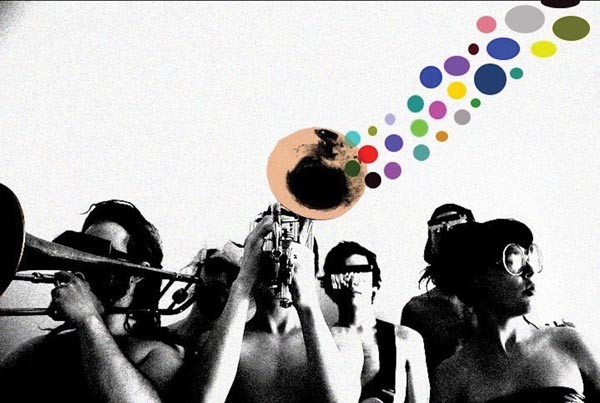Rubblebucket lives in a precarious place.
Not Brooklyn, the band's current physical home — though perhaps that's precarious in its own way. It's more of a precarious psychic place: somewhere between hip indie pop and salt-of-the-earth jam rock. Perched on the border of two subcultures that, despite some similarities, are given to sniping at one another, a band could either bridge the gap or languish in the in-between space.
"I've been trying to wrap my head around ‘jam band,' ‘hippie,' ‘hipster,' ‘indie,' ‘punk' —all these things that I either grew up around or exist in my life now," explains Alex Toth, the group's main songwriter. "And it's really complex. There's a thin line — there's sort of an underground hipster movement now in Brooklyn: All raw food, yoga, the words they use sound like hippie words. There are so many of the same values on both sides.
"My dad was sort of a hippie; Kal's parents are hippies," he adds, referring to his partner, the band's singer, Kalmia Traver. "I think the line's really blurring."
That blurring line might be a ticket to popularity for the big dance-pop ensemble (which was originally called Rubblebucket Orchestra, and still contains all manner of horns and auxiliary percussion). Toth and Traver have an air of non-conformity about them that makes them difficult to nail down as indie hipsters. (Anyway, the truly hip are too stoic to dance as much as Toth and Traver do.) But they also maintain an uncanny knack for tidy songwriting, something valued much more by the pop set than by the everyone-gets-a-solo jam crowd.
Rubblebucket's 2011 release Omega La La garnered critical acclaim and set the band to some serious touring. ("If we did 115 shows last year, we were probably on the road 150, 160 days, with travel days and off days — and this year's probably been more relentless," Toth says.) Its itinerary is generally a mix of festivals — many Pittsburghers were first introduced to the band at the All Good festival nearby — and club shows. (Last year, Rubblebucket played an electric, if sparsely attended, set at the Rex Theater.)
"Festivals can be the most exhilarating experiences ever," Toth says, "because you can have much bigger crowds, or you can have crowds of people that are just so ramped up already, and maybe haven't heard of you, and you're exciting them for the first time. On the other side of it, there are times when people are like, ‘It's so hot; I've been here all day,' and you don't have time to sound-check ... it can be stressful."
Which is why "club shows are great," Toth adds. "It's your show; you can take time with the space to get set up and sound check, and it's a more intimate environment where your fans are there, for you."
The band's roots go back to Toth and Traver's days as college students at the University of Vermont; soon after graduating, they played for a time in a reggae band called John Brown's Body, and Rubblebucket began as an offshoot of that band.
"It didn't start with this fine-tuned aesthetic, at all," says Toth. "It was just — ‘I want to experiment with polyrhythms, I want to play Afrobeat. And I want to do it on my own terms, and in a way that is sculptable in any direction I want to go with it.' An avenue for the wildest ideas of my and Kal's imagination, basically."
But it wasn't long before the band strayed from its original goal and into something else.
"There are certain rules for any sort of authentic music-making," Toth says. "And I quickly started to break the rules of Afrobeat. I was working within it, then I wanted to break away from it in a way, while still drawing on some of that stuff.
"At the time, I was thinking of how inspired I was by — and this might sound cliché — by Radiohead and Bjork. To me, they're some of the most creative, unique artists in the world, and they're doing it on such a hugely successful level. To do it on that level, with that much integrity, that's it for me. That's what I want to do: I want to make music that is incredibly beautiful, that can reach people."
That goes for jam-band aficionados, hipsters and everyone in between (which is probably where most of us lie).
"On any side, you can find staleness," says Toth. "In the jam-band world, I find a lot of times the music can be almost on the level of consumption of a cigarette. I've watched kids consume music the way they'd take a drug: It's this passive distraction to the now, it's not really being engaged. That scene can be really undiscerning. And I really don't like that. But on the indie side, you're gonna have just as much superficial, mail-it-in stuff going on.
"What I want to see in any scene is intelligence, creativity, drive, passion. It doesn't matter if you're dressed like a hippie or a punk or a metal guy or a hipster — it's all about, to me, the depth of the creativity you're putting into the thing."


